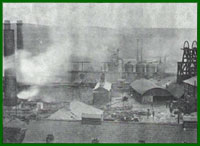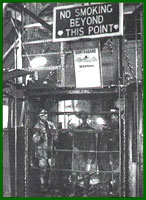 |
|
|||
|
Big
Pit
|
History and Archeology Big Pit stands on the eastern rim of the South Wales Coalfield, where coal outcrops on the hillsides. Iron Ore and limestone were also found here so it was natural for an ironworks to be founded at Blaenavon. The Ironworks were established in 1789 and the remains are now open for visitors and Blaenavon has been declared a World Heritage Site. Big Pit stands on the site of an earlier mine, Kearsley Pit, the shaft of which was sunk to a depth of 39 metres in 1860. Big Pit came into being when the shaft was deepened to a depth of 89 metres. It got its name from the size of its elliptical shaft, which at 5.5m by 4.6m was the first in the area wide enough to wind two trams of coal side by side. Soon the colliery was producing more than 100,000 tonnes of coal from an area of about 12 square miles. As the workings extended out from the shaft the mine incorporated other workings such as Mine Slope and Forge Level, which is now the 'second way out' of the mine. Nine different coal seams were worked at some stage during Big Pit's life and the coal it produced was first-class 'steam coal' for which South Wales became famous around the world. As time went on seams became worked out or uneconomical and were closed down. In Big Pit it was the lowest seam, the Garw, that was the last one worked. It was a first-class coking coal, but with a maximum thickness of 71 cm and a very hard consistency it was difficult to work.
Until 1939 miners travelled to work and home again in their working cloths, but in that year the pithead baths were opened. Each miner now had two lockers - one for his clean cloths and one for his working cloths separated by the showers. The baths now house an exhibition and a licensed café. Output of coal peaked in South Wales in 1913 and at its busiest Big Pit employed 1,300 men. Slow decline followed with the worst period being the slump of the 20s and 30s when there was 57% unemployment in Blaenavon. Work picked up again with the start of the Second World War as coal became a vital commodity, but peace brought a decline in demand and by 1966 Big Pit was the only deep mine left in the Blaenavon area. In 1980, when the mine closed, the workforce had been reduced to only 250. Then in April 1883 Big Pit reopened as a visitor centre. |
|||
|

 For
many years both coal and iron was transported to the coast by road and
canal, but in 1852 the railway from Newport came to Blaenavon and production
started to soar. The first coal was worked in levels or drifts dug into
the hillsides, following the outcropping coal seams. One of these was
the Mine Slope, which dates from around 1840 and was later incorporated
into Big Pit when that was sunk to its present depth in 1880. Another
drift mine, Dodd's Slope, was rediscovered in 1989 and its entrance now
forms part of Big Pit's surface attractions.
For
many years both coal and iron was transported to the coast by road and
canal, but in 1852 the railway from Newport came to Blaenavon and production
started to soar. The first coal was worked in levels or drifts dug into
the hillsides, following the outcropping coal seams. One of these was
the Mine Slope, which dates from around 1840 and was later incorporated
into Big Pit when that was sunk to its present depth in 1880. Another
drift mine, Dodd's Slope, was rediscovered in 1989 and its entrance now
forms part of Big Pit's surface attractions.  Like
in all other coal mines in South Wales the colliers cut the coal by hand
and mechanisation did not come to Big Pit until 1908 when a mechanical
conveyor was installed. The pit was among the first in South Wales to
be electrified, and by 1910 the ventilating fan, pumps and underground
haulage system were all worked by electricity. The winding gear continued
to be driven by a stem engine until 1953. The first of the post war nationalisation
improvements came to Big Pit in the late 1950s in the form of a plough,
which was a mechanical cutter and loader pulled along the face by a chain.
This was the only suitable system for the Garw Seam and the coal was taken
to the surface along a new drift opened in the mid 70s. The main shaft
was left only for maintenance while the workforce entered via the new
drift.
Like
in all other coal mines in South Wales the colliers cut the coal by hand
and mechanisation did not come to Big Pit until 1908 when a mechanical
conveyor was installed. The pit was among the first in South Wales to
be electrified, and by 1910 the ventilating fan, pumps and underground
haulage system were all worked by electricity. The winding gear continued
to be driven by a stem engine until 1953. The first of the post war nationalisation
improvements came to Big Pit in the late 1950s in the form of a plough,
which was a mechanical cutter and loader pulled along the face by a chain.
This was the only suitable system for the Garw Seam and the coal was taken
to the surface along a new drift opened in the mid 70s. The main shaft
was left only for maintenance while the workforce entered via the new
drift.